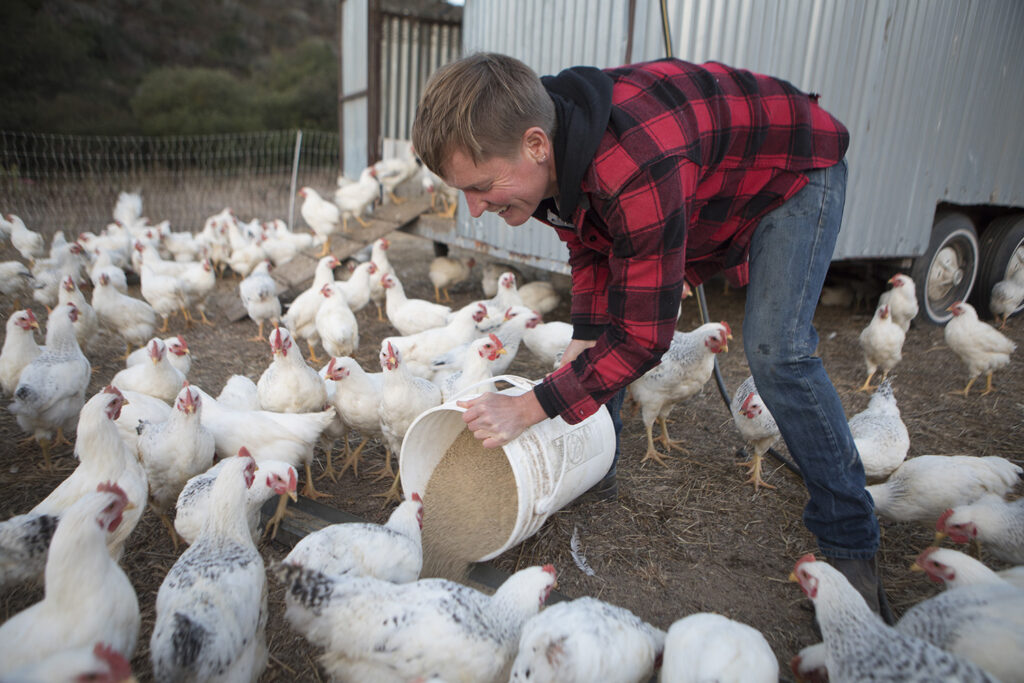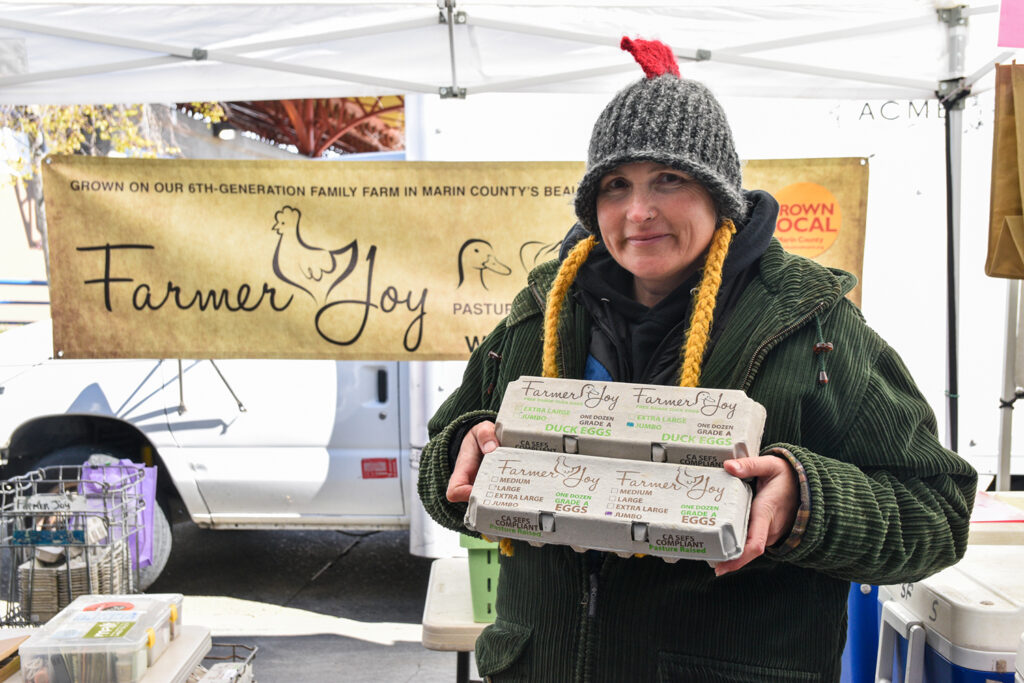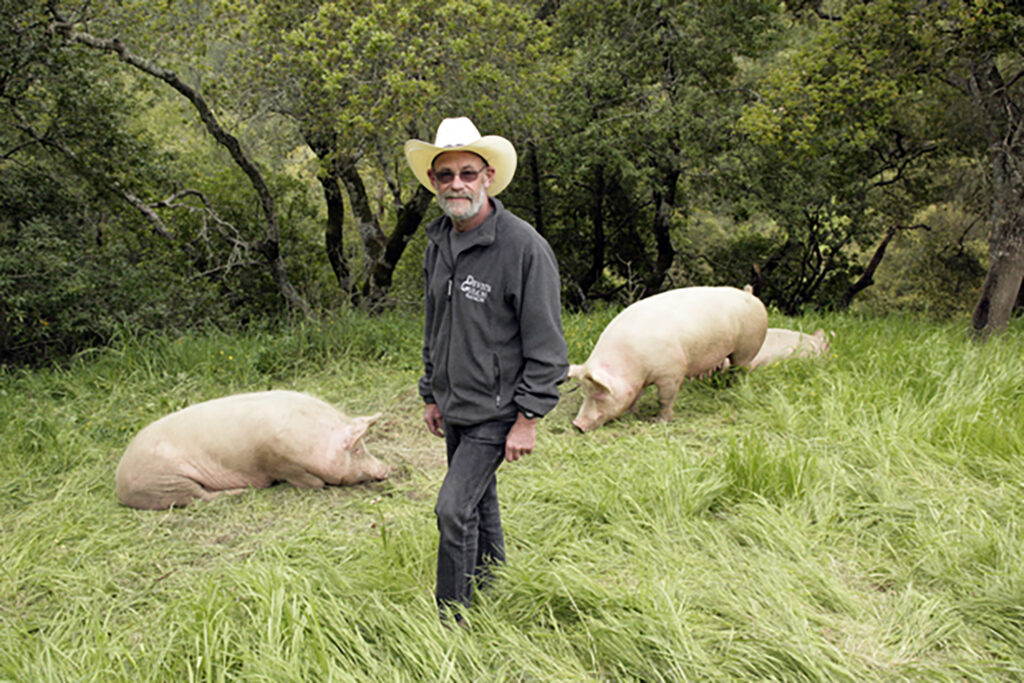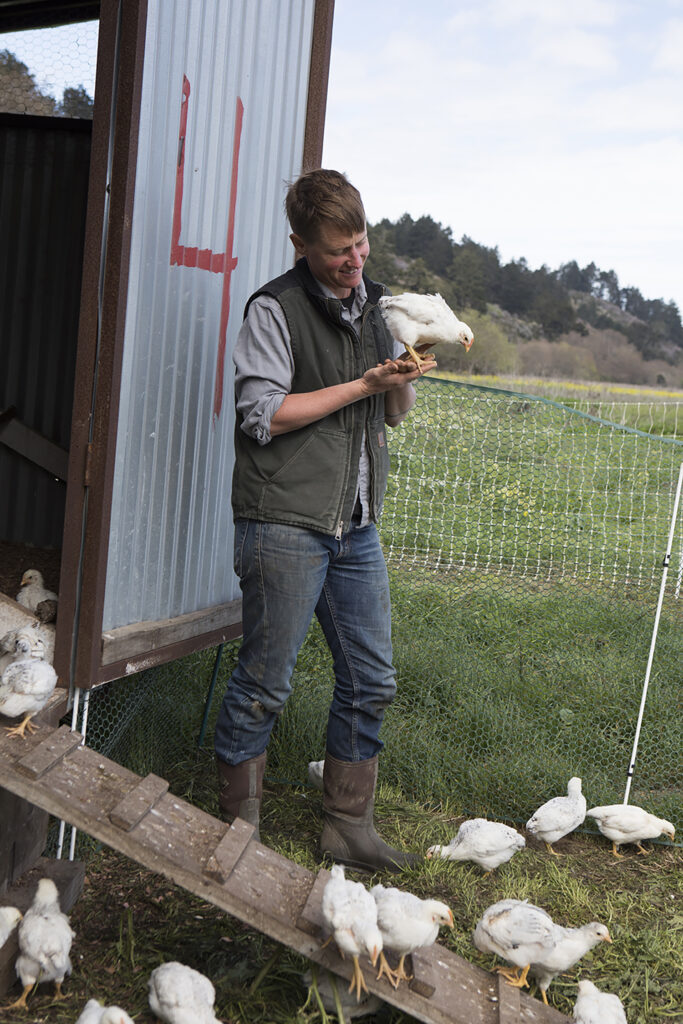Small Ranchers Struggle with Rising Costs and Keeping Food Affordable
Selina Knowles, Communications Coordinator
February 24, 2023

For both the eater and the farmer, rising costs are putting pressure on our food system. You have probably seen food prices rising at farmers markets and stores, and maybe questioned how your grocery bills keep growing, even as you try to moderate your spending. Inflation has touched nearly every aspect of life, with the cost of food in particular increasing 10% over the last 12 months. And farmers are feeling the impact, too.
“One of our goals when we started this business was to be an affordable option for people,” says Joy Dolcini of Farmer Joy, a small pasture-based ranch in Chileno Valley. “We try not to raise our prices too much, but then we end up eating the extra costs.” Humane animal farmers at the Ferry Plaza Farmers Market are grappling with raising high-quality meat and eggs and keeping their small businesses afloat, while maintaining prices that are accessible to as many shoppers as possible.

Feed, Fuel, and Labor Prices Piling Up
“Our sales projections for the year were mostly correct, but our costs were way off,” says Dede Boies, who owns and operates Root Down Farm in Pescadero. “Late spring of last year, we started getting a little scared about making it through the year and had to make some significant changes in order to keep going.”
Like Farmer Joy, Root Down Farm raises their animals sustainably, humanely, and on pasture, in contrast to large-scale concentrated animal feeding operations (CAFOs), which prioritize efficiency and profitability while mistreating animals, polluting the environment, and hurting workers and communities. Farms that use humane ranching practices require more time and care but end up producing meat that is better for animals, people, and the land. Unfortunately, they are also hit harder when production costs go up.
“Everything is costing more, for sure,” says Joy. She lists feed as the top expense for raising her chickens, ducks, and cows. Spiking feed prices continue to challenge livestock farmers across the country. Feed costs make up a third of Root Down Farm’s production costs as well.
The cost of livestock itself is on the rise, too. “Fortunately, we’re able to glean a lot of food for the pigs,” says Joy, “but the price of the pigs themselves has gone up.” According to Joy, the price of piglets, which she purchases about twice a year, have gone up nearly 50 percent, and the cost of chicks have gone up 30 percent.
The rising cost of gas has made things complicated for farm owners who rely on employees to drive into cities to sell at farmers markets and deliver to restaurants and stores. Myriam Kaplan-Pasternak, who runs Devil’s Gulch Ranch with her husband, Mark Pasternak, reports that it’s hard to find workers to drive to the ranch’s locations in Nicasio, Novato, and Petaluma because gas has gotten more expensive.
Already paying employees well above minimum wage, she’s now considering how to adjust wages to cover rising transportation costs, adding to the list of growing business expenses. “I’m wrestling with trying to figure out how to get caught up this month, waiting for money to come in,” she says.

Sustaining Small Businesses While Maintaining Affordability
Unlike larger industrial farms, which can raise prices to drive up their profits, smaller operations navigate sometimes precarious financial situations to take care of their families and animals, while keeping costs low enough for as many farmers market shoppers as possible.
Myriam reports that Devil’s Gulch Ranch’s average market day sales have gone down over the winter season, compounded by lower traffic during January’s wet weather spell as well as ripple effects from wholesale customer trends. She says, “We’re getting a domino effect from our wholesale customers, who are paying us late, and they’re not ordering as much as they used to because they don’t have as many customers.”
While trying to make ends meet as her farming costs go up, Joy is wary of raising prices for her loyal customers, but has had to make some increases. “I think that the people who have noticed the price increase, for the most part, have been expecting it,” she says. “I’ve had customers telling me that I need to raise my prices for a while, but it just hurts me to do that to people.”
At Root Down, Dede shares similar concerns. “We raised prices, and we kept a few things the same,” she says. “I know inflation is impacting everybody and I want people to still be able to afford at least something of ours.”
Acknowledging structural barriers to food access, she adds, “I’m sure there’s a lot of people who simply just can’t afford what we have. And it’s unfortunate that the system is set up the way it is, where products that are grown with actual time and effort and care have to cost so much more.”

Encouraging Transparency Between Farmers and Eaters
On both sides of the farmers market stand, inflation-induced anxiety is an opportunity to continue important conversations about where our food comes from and what goes into growing and raising it. While city-dwellers benefit from fresh, sustainably sourced food from local farms, farmers depend on regular customers to sustain their livelihoods.
“I super-appreciate all of the customers who do come out to the market, especially the ones who come out every week, just knowing that this is how we support our family,” says Joy. “I think it’s important for people to understand how much the farmers value all of their customers.”
Dede says, “I was really scared to increase prices, that we would lose customers, and so I was trying to come at it with more of an educational piece.” When customers wonder about why her products cost what they do, she encourages them to ask questions.
“If you’re put off by the price of something, ask about it. There are so many things that go into growing food and animals that people aren’t thinking about,” she says. “That’s the joy of the farmers market, you get to engage with the people who are, for the most part, growing your food and you can ask anything about it.”
Support Devil’s Gulch Ranch, Farmer Joy, and Root Down Farm at the Ferry Plaza Farmers Market on Saturdays. Learn more about Root Down Farm in The Food Change.
See our 10 ways to stretch your food budget at the farmers market, and learn more about utilizing CalFresh EBT benefits at Foodwise farmers markets with Market Match here. You can also support food access for families in your community by donating to Foodwise here.
Topics: Animal welfare, Farmers, Farms, Humane, Meat/poultry
